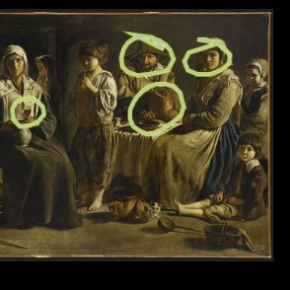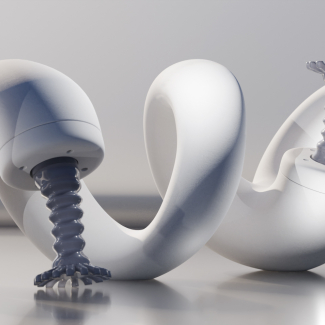
CNRS and the Louvre-Lens museum study perception of art with Ikonikat
The Louvre-Lens museum and its partner, the CNRS, are conducting a novel research project during the museum's Le Nain exhibit: The Le Nain mystery. In all, 600 museum visitors will be using tablets to highlight what most captivates their attention in seven works on display. This tablet input collected throughout the exhibit's duration—from 22 March to 26 June 2017—will be recorded and processed using Ikonikat software. Researchers will use it to determine whether visitors focus on the same details that professionals find most noteworthy. The findings will help the museum redefine how artwork is presented to visitors.
Why ask museum visitors to tell us what they see in a work of art when they can just show us? Ikonikat is the fruit of research coordinated by Mathias Blanc of the Institut de recherches historiques du Septentrion (CNRS / Université Lille 3). The application lets people identify those aspects of an artwork they think are salient by drawing on an image of it. Since Ikonikat does not require knowledge of any specialized art vocabulary, it lets everyone participate, without even having to speak up. Visitors have only to pick up a tablet displaying a picture of the work they are viewing, and then circle, underline, or otherwise mark the pictorial elements they consider essential or intriguing. The lines drawn by users reveal those parts of the painting most significant to them, and the application can indicate the order in which these pictorial elements were singled out.
Ikonikat has already been tried with school groups visiting the Palais des Beaux-Arts de Lille. It will also be used in a novel study involving a much wider population, at the Louvre-Lens museum, during its exhibit of works by the Le Nain brothers: The Le Nain mystery. A total of 600 visitors will take part—alone or in groups of 2 to 15—before or after having discovered the exhibit on their own. They will be asked to use Ikonikat while contemplating seven works presented in various orders.
The application will record the markings they make, and they will also be asked to complete a sociological questionnaire. Analysis of these data will show whether museum visitors and art professionals—that is, museum staff and art historians—share the same perceptions of what is most remarkable about a given work. And it will help researchers understand how the social or cultural context—for example, visiting with family versus a school group—and the order in which works are viewed shape these perceptions.
The museum will also benefit from this program, which will allow its staff to reassess their approach to visitor interaction—and specifically, how they display and discuss artwork.
Scheduled presentations throughout the course of the exhibit will keep visitors abreast of program developments and findings.
The Le Nain brothers' exhibit will also be the focus of an international research workshop, with support from the Franco-German University, the University of Strasbourg IdEx, and the German Academic Exchange Service (DAAD). From March 28 to 31, 2017, French, Austrian, German, and English sociologists and art historians will draw on a selection of exhibit works to contextualize their approaches to the analysis of images, how they are perceived (i.e., what we see), and how they are interpreted (i.e., what meanings we give them). After a day at the Louvre-Lens museum, the workshop organized by Mathias Blanc will continue in the Lille metropolitan area.
Ikonikat is one of three applications for the collaborative study of images that make up the VISUALL-tek suite. These tools were inspired by interdisciplinary dialogue between social scientists and computer scientists specialized in human-computer interaction, from the Centre de recherche en informatique, signal et automatique de Lille (CNRS / Université Lille 1 / École centrale de Lille).
Exhibit: The Le Nain mystery
22 March – 26 June 2017
Born in Laon, in Picardy, the Le Nain brothers were among the most talented artists of the 17th century. Several of their paintings have become icons of art history. However, the attribution and meaning of these works often remain enigmatic, constituting one of the greatest mysteries in French painting.
The exhibition immerses the visitor in the puzzling "Le Nain mystery", with an investigation into Louis the unknown genius, Antoine the portraitist and Mathieu, the ambitious brother. Explore the historical archives, find portraits hidden beneath other paintings, and discover the secrets of the Le Nain brothers' art!
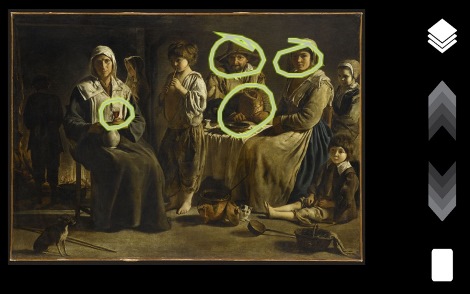
Ikonikat interface displaying Peasant Family in an Interior by Louis Le Nain.
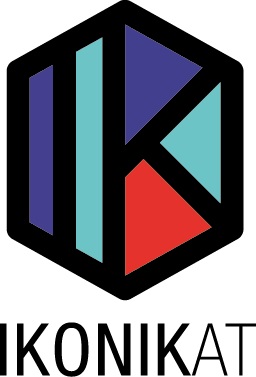
Ikonikat logo
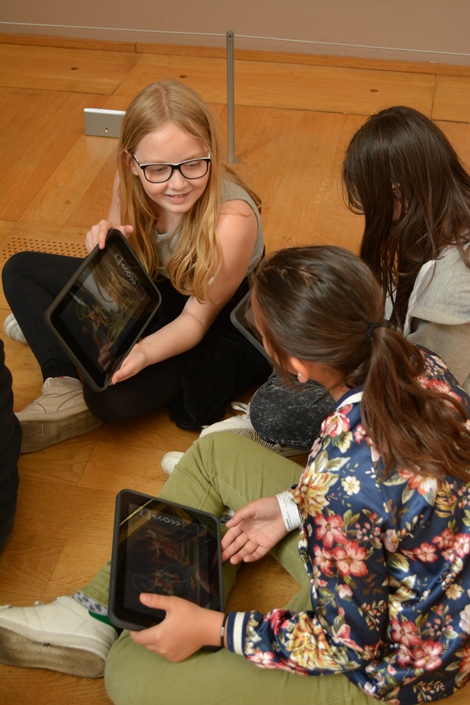
A group of students using Ikonikat at the Palais des Beaux-Arts de Lille.
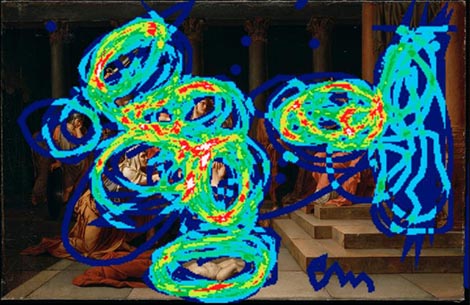
Heat map showing density of marks drawn by visitors: blue areas are rarely marked; red areas are most frequently marked).
Painting: Jean-Baptiste Wicar, The judgment of Solomon. Oil on canvas, 96 × 150 cm, 1785. Palais des Beaux-Arts de Lille.
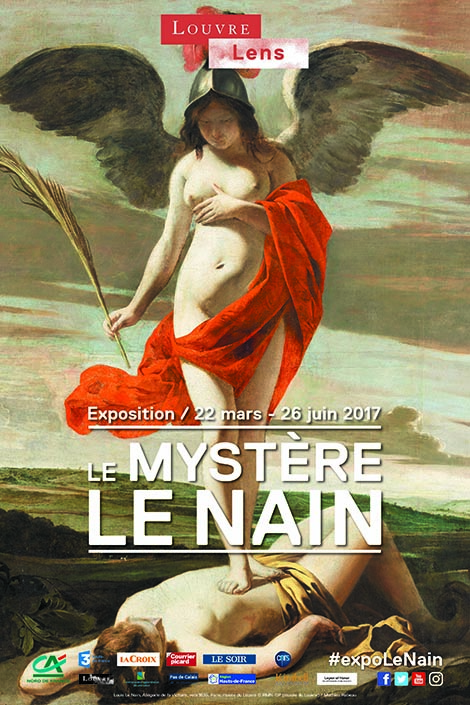
About the Louvre-Lens Museum / www.louvrelens.fr
Inaugurated in December 2012, the Louvre-Lens museum is located on a former coal mine, at the heart of the former Mining Basin of Northern France, now a World Heritage Site by Unesco. In a building of glass and light, with a resolutely contemporary architecture, it hosts the prestigious collections of the Louvre and presents temporary exhibitions of international scope. The spectacular Gallery of Time offers a visiting experience like no other in the world. It offers an unprecedented journey through the history of art, from the emergence of writing in the 4th millennium BC to the industrial revolution in Europe in the mid-19th century. Its elegant and innovative scenography creates a new dialogue between eras, techniques and civilizations.
About the CNRS / www.cnrs.fr/en
The French National Center for Scientific Research is Europe's largest public research institution. It produces knowledge for the benefit of society. With nearly 32,000 employees, a budget exceeding 3.3 billion euros in 2015 (including a self-generated income of 769 million euros), and offices throughout France, the CNRS is present in all scientific fields through its 1100 laboratories. With 21 Nobel laureates and 12 Fields Medal winners, the organization has a long tradition of excellence.
